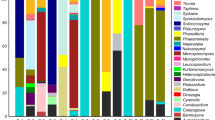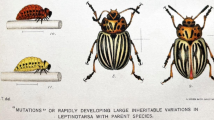Abstract
The Dictyostelid or cellular slime moulds (CSMs) are soil amoebae with an asexual life cycle involving social behaviour and division of labour. The most obvious distinction is between ‘germ line’ or pre-spore cells, which survive, and ‘somatic’ or pre-stalk cells, which eventually die. A plausible hypothesis to explain the apparent altruism of pre-stalk cells is that it is directed at clonal relatives. We have tested this hypothesis by comparing indices of altruistic behaviour between clonal and chimeric (genetically heterogeneous) social groups. The groups were generated by mixing amoebae belonging to distinguishable strains of Dictyostelium giganteum. The amoebae of one strain do not aggregate at all when mixed with any of three other strains and aggregate poorly with a fourth. Among the latter, co-aggregation occurs but is followed by varying extents of sorting out. At times, two strains form separate fruiting bodies; in other cases, they remain together but are clustered in clonal groups within a single chimeric structure. Our expectation was that the allocation of cells to the stalk pathway would be higher, and to the spore pathway lower, in clonal social groups than in chimeras. The expectation was not always fulfilled. In addition, three strains could be arrayed in a linear rank order in terms of the relative efficiencies of spore-formation in binary mixtures; but when all three were mixed, they were equally efficient. More than overall genetic similarity, cell fate in a chimera seems to result from complex non-linear interactions based on epigenetic differences.





Similar content being viewed by others
References
Atzmony D, Zahavi A, Nanjundiah V (1997) Altruistic behaviour in Dictyostelium discoideum explained on the basis of individual selection. Curr Sci 72:142–145
Bonner JT (1967) The cellular slime molds, 2nd edn. Princeton University Press, Princeton
Bonner JT (1982) Evolutionary strategies and developmental constraints in the cellular slime molds. Am Nat 119:530–552
Bonner JT, Adams MS (1958) Cell mixtures of different species and strains of cellular slime moulds. J Embryol Exp Morphol 6:346–356
Bonner JT, Lamont DS (2005) Behaviour of cellular slime molds in the soil. Mycologia 97(1):178–184
Bonner JT, Slifkin MK (1949) A study of the control of differentiation: the proportions of stalk and spore cells in the slime mold Dictyostelium discoideum. Am J Bot 36:727–734
Bonner JT, Koontz PG Jr, Paton D (1953) Size in relation to the rate of migration in the slime mold Dictyostelium discoideum. Mycologia 45:235–240
Clerc A, Manceau C, Nesme X (1998) Comparison of randomly amplified polymorphism to assess genetic diversity and genetic relatedness within genospecies III of Pseudomonas syringae. Appl Environ Microbiol 64(4):1180–1187
Foster KR, Fortunato A, Strassmann JE, Queller DC (2002) The costs and benefits of being a chimera. Proc R Soc Lond B Biol Sci 269:2357–2362
Francis D, Eisenberg R (1993) Genetic structure of a natural population of Dictyostelium discoideum, a cellular slime mold. Mol Ecol 2:385–391
Gadagkar R, Bonner JT (1994) Social insects and social amoebae. J Biosci 19:219–245
Gross JD (1994) Developmental decisions in Dictyostelium discoideum. Microbiol Rev 58:330–351
Huang SC, Tsai CC, Sheu CS (2000) Genetic analysis of Chrysanthemum hybrids based on RAPD molecular markers. Bot Bull Acad Sin (Shanghai) 41:257–262
Kaushik S (2002) Genetic heterogeneity and social behaviour in cellular slime molds. Ph.D. thesis, Indian Institute of Science, Bangalore, India
Kaushik S, Nanjundiah V (2003) Evolutionary questions raised by cellular slime mould development. Proc Indian Natl Sci Acad B 69:825–852
Kawli T, Kaushik S (2001) Cell fate choice and social evolution in Dictyostelium discoideum: interplay of morphogens and heterogeneities. J Biosci 26:130–133
Legendre P, Legendre L (1998) Numerical ecology, 2nd English edn. Elsevier, Amsterdam, 853 pp
Matsuda H, Harada Y (1990) Evolutionarily stable stalk to spore ratio in cellular slime molds and the law of equalization in net incomes. J Theor Biol 147:329–344
Nanjundiah V (1985) The evolution of communication and social behaviour in Dictyostelium discoideum. Proc Indian Acad Sci (Anim Sci) 94:639–653
Raper KB (1940) Pseudoplasmodium formation and organization in Dictyostelium discoideum. J Elisha Mitchell Sci Soc 56:241–282
Raper KB (1984) The dictyostelids. Princeton University Press, Princeton, NJ
Ratnayeke S, Tuskan GA, Pelton MR (2002) Genetic relatedness and female spatial organization in a solitary carnivore, the raccoon Procyon lotor. Mol Ecol 11(6):1115–1124
Sambrook J, Fritsch EF, Maniatis T (1989) Molecular cloning: a laboratory manual. Cold Spring Harbor Laboratory, Cold Spring Harbor
Saran S, Azhar M, Manogaran PS, Pande G, Nanjundiah V (1994) The level of sequestered calcium in vegetative amoebae of Dictyostelium discoideum can predict post-aggregative cell fate. Differentiation 57:163–169
Strassmann JE, Zhu Y, Queller DC (2000) Altruism and social cheating in the social amoeba Dictyostelium discoideum. Nature 408:965–967
Acknowledgements
We are grateful to J.C. Cavender for help in identifying the strains, and thank J.T. Bonner, R. Gadagkar and K. Inouye for several helpful comments on an earlier version of the manuscript. The text has benefited substantially from the detailed criticisms of anonymous referees. B.K. acknowledges the award of a Senior Research Fellowship from the Council of Scientific and Industrial Research.
Author information
Authors and Affiliations
Corresponding author
Additional information
Communicated by T. Czeschlik
Rights and permissions
About this article
Cite this article
Kaushik, S., Katoch, B. & Nanjundiah, V. Social behaviour in genetically heterogeneous groups of Dictyostelium giganteum . Behav Ecol Sociobiol 59, 521–530 (2006). https://doi.org/10.1007/s00265-005-0077-9
Received:
Revised:
Accepted:
Published:
Issue Date:
DOI: https://doi.org/10.1007/s00265-005-0077-9




